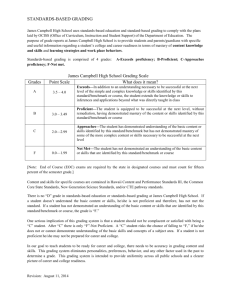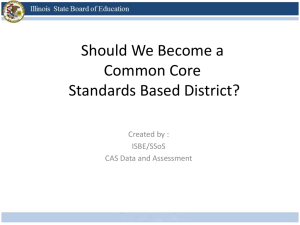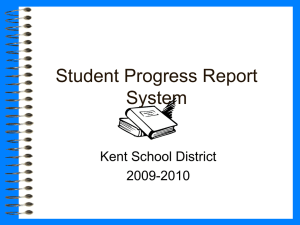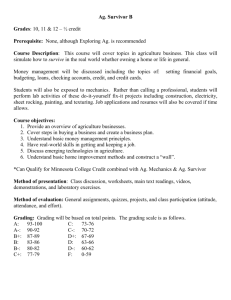Seven Reasons for Standards-Based Grading
advertisement
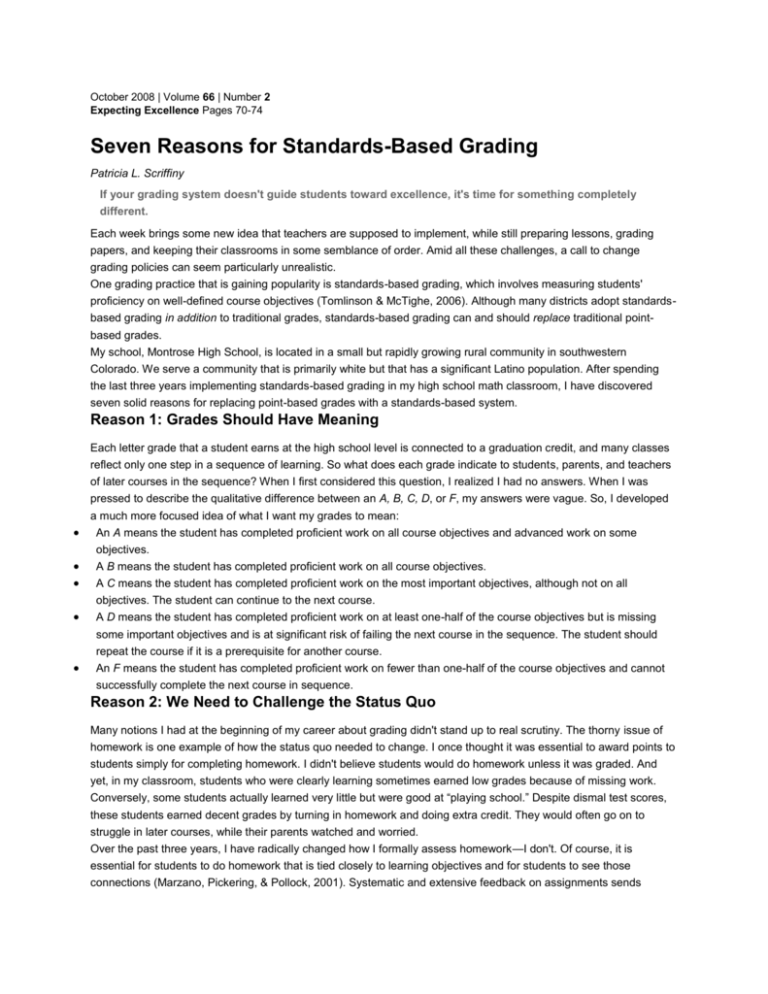
October 2008 | Volume 66 | Number 2 Expecting Excellence Pages 70-74 Seven Reasons for Standards-Based Grading Patricia L. Scriffiny If your grading system doesn't guide students toward excellence, it's time for something completely different. Each week brings some new idea that teachers are supposed to implement, while still preparing lessons, grading papers, and keeping their classrooms in some semblance of order. Amid all these challenges, a call to change grading policies can seem particularly unrealistic. One grading practice that is gaining popularity is standards-based grading, which involves measuring students' proficiency on well-defined course objectives (Tomlinson & McTighe, 2006). Although many districts adopt standardsbased grading in addition to traditional grades, standards-based grading can and should replace traditional pointbased grades. My school, Montrose High School, is located in a small but rapidly growing rural community in southwestern Colorado. We serve a community that is primarily white but that has a significant Latino population. After spending the last three years implementing standards-based grading in my high school math classroom, I have discovered seven solid reasons for replacing point-based grades with a standards-based system. Reason 1: Grades Should Have Meaning Each letter grade that a student earns at the high school level is connected to a graduation credit, and many classes reflect only one step in a sequence of learning. So what does each grade indicate to students, parents, and teachers of later courses in the sequence? When I first considered this question, I realized I had no answers. When I was pressed to describe the qualitative difference between an A, B, C, D, or F, my answers were vague. So, I developed a much more focused idea of what I want my grades to mean: An A means the student has completed proficient work on all course objectives and advanced work on some objectives. A B means the student has completed proficient work on all course objectives. A C means the student has completed proficient work on the most important objectives, although not on all objectives. The student can continue to the next course. A D means the student has completed proficient work on at least one-half of the course objectives but is missing some important objectives and is at significant risk of failing the next course in the sequence. The student should repeat the course if it is a prerequisite for another course. An F means the student has completed proficient work on fewer than one-half of the course objectives and cannot successfully complete the next course in sequence. Reason 2: We Need to Challenge the Status Quo Many notions I had at the beginning of my career about grading didn't stand up to real scrutiny. The thorny issue of homework is one example of how the status quo needed to change. I once thought it was essential to award points to students simply for completing homework. I didn't believe students would do homework unless it was graded. And yet, in my classroom, students who were clearly learning sometimes earned low grades because of missing work. Conversely, some students actually learned very little but were good at “playing school.” Despite dismal test scores, these students earned decent grades by turning in homework and doing extra credit. They would often go on to struggle in later courses, while their parents watched and worried. Over the past three years, I have radically changed how I formally assess homework—I don't. Of course, it is essential for students to do homework that is tied closely to learning objectives and for students to see those connections (Marzano, Pickering, & Pollock, 2001). Systematic and extensive feedback on assignments sends students the message that they can and should do homework as practice. A typical homework assignment for my students consists of a small collection of problems, each of which is linked to a learning objective. At first, I make those connections for my students, but eventually they make them on their own. When I assign homework, I discuss with my students where and how it applies to their assessments. My goal is to get students to constantly ask themselves, “Do I know this? Can I do this?” To my surprise, my homework completion rates have remained steady over the past three years. Some students don't do all of the homework that I assign, but they know that they are accountable for mastering the standard connected to it. Of course, not every student who needs to practice always does so, but I am amazed and encouraged that students ask me for extra practice fairly regularly. Reason 3: We Can Control Grading Practices One of the biggest sources of frustration in schools today is the sense that we are at the mercy of factors we teachers cannot control. We cannot control student socioeconomic levels, school funding, our salaries, our teaching assignments, increasing class sizes, difficult parents, or a host of other important issues. However, we can control how we assess students. When I approached my principal and district officials with the idea of using an experimental grading system, I received support and encouragement from all of them. In addition, a number of colleagues have been intrigued and want to make standards-based grading work in their classrooms. If a teacher must use a point system to satisfy an administrative mandate or to use a particular grade book, that teacher can still use a standards-based system. The crucial idea is to use a system that is not based on the inappropriate use of averages. The system must not allow students to mask their level of understanding with their attendance, their level of effort, or other peripheral issues. I have found that avoiding point values that might appear in a traditional percentage-based system is helpful because parents and students can get confused if they see numbers that look like what they've seen in the past but refer to a different scale. Teachers who have to assign points can avoid this confusion by using completely different numbers. A point value in the range of 1 to 10, for example, would not have the strong associations of a point value of 85, and thus would not be as easily misinterpreted. Reason 4: Standards-Based Grading Reduces Meaningless Paperwork Since I adopted standards-based grading, my load of meaningless paperwork has been drastically reduced, which provides time for more important considerations. Standards-based grading enables me to get the most from every piece of paper students turn in. Writing feedback only on selected homework problems saves my time when marking papers while still giving me a sense of where students are in their learning. These homework assignments and other formative assessments help me judge the progress of the group as a whole before deciding how to proceed. I don't assess student mastery of any objective until I am confident that a reasonable number of students will score proficiently, and that makes each assessment mean much more. Students who are still struggling after a significant portion of the class has demonstrated mastery can retest individually. The bottom line is that when I review any set of papers, I walk away knowing a great deal more about what my students know than I ever did before. Reason 5: It Helps Teachers Adjust Instruction Imagine two different grade books for the same set of students, as shown in Figure 1. Which one of the two better illustrates what students know and what they still need to learn? Figure 1. Comparing Traditional and Standards-Based Grade Books Traditional Grade Book Name Homework Average Quiz 1 Chapter 1 Test John 90 65 70 Bill 50 75 78 Susan 110 50 62 Felicia 10 90 85 Amanda 95 100 90 Objective 2: Identify the elements of a story Objective 3: Compare and contrast two stories Standards-Based Grade Book Name Objective 1: Write an alternate ending for a story John Partially proficient Proficient Partially proficient Bill Proficient Proficient Partially proficient Susan Partially proficient Partially proficient Partially proficient Felicia Advanced Proficient Proficient Amanda Partially proficient Advanced Proficient The standards-based grade book gives a wealth of information to help the teacher adjust instruction. Note that two objectives (1 and 3) may require more class instruction. The notations for Objective 2, on the other hand, suggest that the class only needs practice and one student needs some reteaching. Students can also see much more information about their learning. In the traditional grade book, Amanda would assume she is in great shape, but standards-based grading reveals that she has not mastered a crucial concept. Gifted and talented students can be truly challenged in a standards-based classroom because if they show early mastery of fundamental skills and concepts, they can then concentrate on more challenging work that is at higher levels of Bloom's taxonomy or that seeks connections among objectives. Students who struggle can continue to retest and use alternate assessments until they show proficiency, and they are not penalized for needing extended time. I guide students with special needs to modify their work and, if needed, develop different ways of demonstrating that they've met their proficiency goals. Their working styles can be easily accommodated in this system because modified assignments and assessments require no special adjustments in the grade book. The grade book simply shows where they are in meeting the standards, without reference to how they are demonstrating their learning or what modifications needed to be made. Reason 6: It Teaches What Quality Looks Like In the adult world, everything is a performance assessment. If adults on the job make poor decisions or cannot determine the quality of their own work, the results are generally undesirable. Quality matters, and the ability to measure the quality of one's own work is a learned skill. So how can we teach this essential skill? One way to teach quality is to demand it. We must create an environment where standards can and must be met and where students are not permitted to submit substandard work without being asked to revise. If we base our grades on standards rather than attendance, behavior, or extra credit (which often has nothing to do with course objectives), we can actually help students grapple with the idea of quality and walk away with a higher degree of self-sufficiency. We can and should report information about student performance in areas like attendance and effort, but we can report it separately from academic achievement (O'Connor, 2007; Tomlinson & McTighe, 2006). Reason 7: It's a Launchpad to Other Reforms When I began using standards-based grading, I quickly discovered that I needed to reexamine my curriculum. Each class needed a clear and concise set of standards with precise levels of mastery. This prompted a number of discussions with other teachers in my department, and each year we continue to adapt our objectives. No one can use standards-based grading without clear standards. In addition to improving curriculum, I have found new ways to use formative assessments and intervention strategies. My work with special education students and English language learners in particular goes much more smoothly because all the modification needed is already built into what I do. I have also been able to work much more effectively with parents by giving them better information. How do students respond to this style of grading? Of course, their reactions vary. It takes time, discussion, and reflection for students to understand their rights and responsibilities in such a system, and teachers must be patient as students and parents adjust. Many students have expressed increased satisfaction with having a larger degree of control over their grades, although some students do not like the revisions they are required to do. Some struggle to overcome test anxiety and need access to alternate assessments. As for parents, many of them simply want opportunities for their children to succeed, so they are grateful for the revision and retesting. Each year, parents ask thoughtful questions, with some noting that this method of grading is more similar to evaluation in the workplace. These seven reasons to change to standards-based grading are merely a starting point. High school teachers need to hold their own practices up to scrutiny and decide whether those practices are worth keeping. By doing so, we unleash a force for change that we can control, with our students and parents as partners. References Marzano, R., Pickering, D., & Pollock, J. (2001). Classroom instruction that works. Alexandria, VA: ASCD. O'Connor, K. (2007). A repair kit for grading: 15 fixes for broken grades. Portland, OR: Educational Testing Service. Tomlinson, C., & McTighe, J. (2006). Integrating differentiated instruction and understanding by design. Alexandria, VA: ASCD. Patricia L. Scriffiny is a math teacher at Montrose High School in Montrose, Colorado; pscriffiny@mcsd.k12.co.us. Copyright © 2008 by Association for Supervision and Curriculum Development
